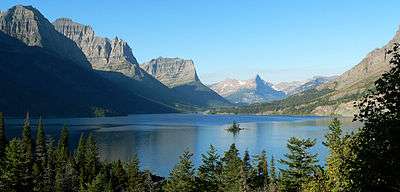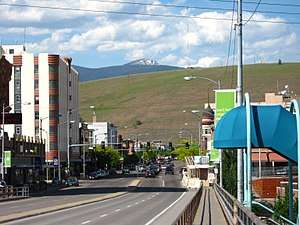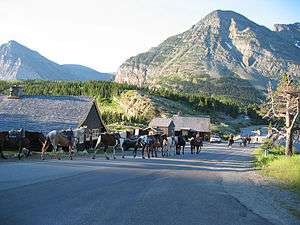Northwestern Montana
Northwestern Montana is a mountainous region of Montana in the United States of America, best known for the sprawling Glacier National Park and the cities of Missoula and Kalispell.

Cities
- 🌍 Missoula , largest city in the region; home to the University of Montana.
- 🌍 Kalispell , base for outdoor activities at West Glacier and the Flathead Valley.
- 🌍 Cut Bank , a small town serving the eastern side of Glacier Park.
- 🌍 Libby , near the Kootenai National Forest and Kootenai River; popular with hunters.
- Seeley Lake , known for its cross-country skiing and snowmobiling trails.
- 🌍 Whitefish , a resort town near Flathead Lake.
- 🌍 Hungry Horse
- 🌍 Superior , a small city on the Clark Fork River that is near the beautiful mountain views at Diamond Lake.
- 🌍 Thompson Falls
- 🌍 Troy
- 🌍 Ravalli , a village at the intersection of US 93 and MT 200.
- 🌍 Polson , a small town on the Flathead Indian Reservation.
- Ronan
Other destinations
- 🌍 Glacier National Park has innumerable opportunities for hiking, fishing, boating, and camping, on a vast scale – the park is bigger than the entire state of Rhode Island.
- The Flathead Valley contains still more outdoor activities, including Flathead Lake and two ski resorts.
- Seeley Lake, southeast of Glacier Park, is a less-crowded alternative with more convenient access to Missoula.
- The St. Ignatius Mission, in St. Ignatius, has historical roots extending to the 1830s, and some of the most beautiful church murals in Montana. The log cabin outside the main church has nuns' headstones worked into the floor and walls--an unusual feature in this area.
- The Garden of One Thousand Buddhas is a stunning Tibetan Buddhist site. One thousand Buddha statues radiate in wheel spokes from a twenty-four-foot Prajnaparamita hub, in the midst of the Jocko Valley, which is, itself, no scenic slouch. The garden is located at 34765 White Coyote Road, outside of Arlee.
Understand

Northwestern Montana has long relied on its natural resources. Lumber and mining are mainstays of the economy, but those same mountains and forests now draw tourists in great numbers as well. The terrain is some of the most varied in the Mountain West, with the Bitterroot and Continental Divide branches of the Rocky Mountains flanking it on west and east, leaving a mixture of freshwater lakes, prairies, glaciers, rivers, and forests between.
Winter weather is milder than the rest of Montana, due to the shielding effect of the mountains – the average temperature typically floats between 20 and 40 degrees. Spring is rainy and unpredictable, but summer and autumn are consistently pleasant with late sunsets.
Get in
By plane
Missoula International Airport (MSO IATA) and Glacier Park International Airport (FCO IATA) (near Kalispell) have connections throughout the western United States on several airlines. Despite the names, neither has any scheduled service to Canada.
By car
Interstate 90 passes through Missoula, connecting from Idaho on the west towards Southwestern Montana and Butte on the east. U.S. Route 12 overlaps I-90 through most of western Montana, until diverging at Garrison and continuing east to Helena. Further north, the scenic U.S. Route 2 connects Kalispell and the west entrance to Glacier Park, then skirts the southern boundary of the park as far as East Glacier before entering the plains of North Central Montana.
The major north-south artery is U.S. Route 93, linking almost every city in the region and continuing to Twin Falls, Idaho. Route 93 is prone to clogging with traffic, particularly on summer weekends.
By train
Amtrak operates the Empire Builder service daily between Seattle/Portland and Chicago. Stops are made at Libby, Whitefish, West Glacier, Essex (flag stop), East Glacier (seasonal – summer), Browning (seasonal – winter), and Cut Bank.
By foot
For the dedicated long-distance hiker the Continental Divide National Scenic Trail (in short Continental Divide Trail) is a United States National Scenic Trail running 3,100 miles between Mexico and Canada. It follows the Continental Divide of the Americas along the Rocky Mountains and traverses five U.S. states; Montana, Idaho, Wyoming, Colorado, and New Mexico.
Get around
A car is essential for most travel through the region. Rimrock Trailways (406-245-5392, 800-255-7655, ) provides scheduled bus service once daily between Whitefish and Missoula via Kalispell.
See
Within Glacier, the Going-To-The-Sun Road crosses the park from west to east, offering spectacular panoramas. At the midpoint, the Logan Pass Visitor Center is the base for a variety of short, scenic hiking trails. The park provides shuttle service from the west entrance, which is recommended for nervous drivers – for much of the westbound drive, the only thing separating the road from a cliff face is an eighteen-inch stone wall! Portions of the road stay open year-round, but the higher elevations and through route are only accessible from June through October, weather permitting.
Do
Outdoor activities galore - camping, hiking, fishing, hunting, boating, golfing, rafting, etc. Between Glacier, numerous state parks, and the private resort areas, it's almost harder to find some place where these aren't options.
The area has several major ski resorts. Whitefish Mountain and Blacktail Mountain are the largest in the Flathead Valley/Kalispell area, and the Montana Snowbowl is near Missoula. Lookout Pass straddles the Idaho—Montana state line, allowing the unusual opportunity to ski through two states on one run.
Stay safe

Visiting Northwestern Montana is a safe and rewarding experience if common sense and good judgment are followed. Unfortunately this is not always the case so please take the following guidelines to heart.
Roads
- During the winter, smaller secondary roads are often closed entirely, and even the Interstate can shut down rapidly when the weather turns poor. Verify weather conditions and road status before setting out, and travel with emergency supplies. Unpaved roads are typically impassable for over half the year.
Wildlife
- Though many of the animals in the area are used to seeing humans, the wildlife is nonetheless wild and should not be fed or disturbed. Stay at least 100 m away from bears and 25 m from all other wild animals! No matter how docile they may look, bison, elk, moose, bears, and nearly all large animals can attack, and every year dozens of visitors are injured because they didn't keep a proper distance. These animals are large, wild, and potentially dangerous, so give them their space. Be especially cautious while traveling at night as animals (especially deer) are known to wander onto roadways.
- Never feed wild animals, especially predators. There are many reasons for this, but amongst them is that animals who become habituated to being fed by humans may be considered a nuisance. Bears and predators that frequent places that humans go, and cannot be broken of the habit, are subject to being killed as a safety precaution. Indirectly, whoever feeds the animals would be responsible for their deaths.
- Included in not feeding is proper food storage and disposal in wild areas. If you are not already familiar with proper procedures, take time to read through guidelines before you go.
Weather
- The weather can change rapidly and with little warning. A sunny, warm summer day can quickly become a cold, rainy or even snowy experience. Hypothermia can be a concern. Be prepared for a variety of weather conditions by bringing along appropriate clothing. Lightning can and does injure and kill people in the area, so watch the sky and take shelter in a building if you hear thunder.
Hiking and camping
There's no reason to fear the mountains, as long as you approach them with proper respect and preparation. As with anywhere else, recklessness and a lack of forethought can get you into trouble, especially in Montana's vast back country.
- Altitude sickness - Can lead to dizziness, headaches, nausea, even blackouts and pulmonary edema. Give your body a few days to adjust to the high altitudes before going full throttle with your hiking or skiing.
- Dehydration - When you engage in strenuous outdoor activities, be sure to replenish your fluids as you go. You may be losing moisture through your mouth and nose and through sweating, but be completely unaware due to the arid mountain air. May result in dizziness, intense thirst and elevated heart and breath rates.
- Giardia - Drinking untreated water from regional streams is not a good idea owing to Giardia parasites, but tap water is not a problem.
- Hypothermia - Prolonged exposure to the cold can result in confusion, a slowed heart rate, lethargy, even death. Dress warmly in non cotton clothing to allow any sweat to wick away from your body and evaporate. Otherwise, it may thoroughly chill you later in the day when temperatures drop.
- Frostbite - During periods of severe cold, your circulatory system pulls all your warming blood into the core of your body to protect your vital organs. This makes your extremities such as your ears, fingers and nose especially vulnerable. Wear a face mask, insulated gloves and other heavy gear on the worst winter days. It gets cold sitting still on those ski lifts!
- Sunburn - Lather up with sunscreen, even if there's cloud cover. Montana's high elevation means you have less protection to the sun's powerful ultra violet rays. This can be compounded while skiing or snowboarding, when the rays are reflected off the snow and hits the underside of your jaw. Don't forget to wear UV-rated goggles or sunglasses, as well.
- Know your 10 essentials when going on a hike, because cell phones won't always work in many rural areas, and may not be depended on in an emergency situation.
- Navigation
- Hydration and nutrition
- Pocket knife
- Sun protection
- Insulation
- Fire
- Lightning
- First Aid
- Shelter
- Whistle
Crime
Finally, with so many people visiting the area each year petty crimes are something to be vigilant against. Lock your car doors and exercise sensible precautions with valuables, especially when leaving your vehicle at trail-heads or anywhere you might be away from your vehicle for any length of time.
Go next
Glacier Park is joined across the Canadian border with Waterton Lakes National Park in Alberta.